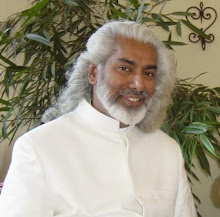Shiva
as Dakshinamurti represents the Guru, the teacher, He who initiates
and gives knowledge to those who seek it. He is the personification
of supreme knowledge and wisdom. And he is worshipped as the god of
divine wisdom.
 |
| Shiva as Dakshinamurthy |
Dakshina
first means the right direction. For almost all auspicious acts and
rituals we face East, because the East is where the sun rises every
day. It is where auspiciousness is born. When we face East, our right
hand side is the South. That is how the Southern direction came to be
know as 'dakshina'. And Shiva in his aspect of divine teacher is
always facing South and is therefore called Dakshinamurti. When we
enter a temple in southern India and follow the prakara in the
clock-wise direction, we find Dakshinamurti in the central niche of
the southern wall of the sanctum.
Around
him sit four sages who are named Sanatkumara (always a youth), Sanaka
(ancient), Sanatana (eternal), Sanandana (having joy). They are born
from the mind of Brahma and live eternally as Brahmacaris. With the
chin mudra Dakshinamurti and with great silence he teaches his four
sishyas or disciples the meaning of Brahma Vidya, the knowledge of
Brahman. The significance of Brahma
Vidya is to realise Parabrahmam or the divine knowledge or wisdom. To
know about the Brahmam is to know about the Paramatma. Through
this teaching they receive all kinds of knowledge and wisdom.
Dakshinamurthy
sits in a yogic pose called veerasana. He sits on a tiger skin which
shows his yogic powers. With one leg he connects to our world, the
world of ignorance and illusion. His other leg is folded across in a
yogic pose, generating the energy. In his hair he wears the crescent
moon. On his forehead is his third eye. In his four hands he holds
his attributes. The tradition reaches us about 108 forms of
Dakshinamurti. Among these Jñana Dakshinamurthy, Samhara
Dakshinamurthy, Lakudi Dakshinamurthy, Yoga Dakshinamurthy, Metha
Dakshinamurthy, Samba Dakshinamurthy and Veenadhara Dakshinamurthy
are the most familiar.
He
sits under the asvattha tree. This is the sacred tree which is
described in the Veda as having its roots in heaven and its branches
below in our world. It is the tree which represents the cosmos. Of
tis it is said in the Katha Upanishad
“This
is That eternal Asvattha Tree with its root above and branches below.
That root, indeed, is called the Bright. That is Brahman, and That
alone is the Immortal. In That all worlds are contained, and none can
pass beyond. This verily is That.”
(Katha Upanishad II.iii.1)
When
we worship this great lord who offers us darshan under that Cosmic
Tree we will receive great knowledge and wisdom.
Kandhan Raja
Kandhan Raja



No comments:
Post a Comment